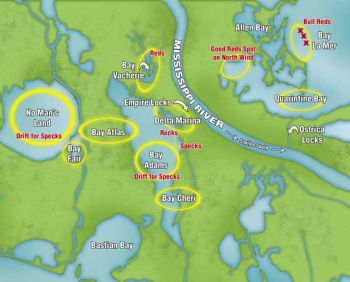
Gazing from atop the Empire Bridge in southern Plaquemines Parish, one can see literally thousands of white PVC pipes sticking up from atop oyster beds.
Prior to Hurricane Katrina, this area was home to the state’s largest oyster operation. Since the storm, a flurry of activity has returned, and oystermen and their dredges can be seen working the vast area to the west of the Empire Bridge.
As we idled out of Delta Marina at sunrise, small boats were already lined up just outside the Empire floodgates, and excited anglers swung speckled trout into their vessels two at a time.
“Most of our guys come down here in 15- to 16-foot Bass Trackers,” said Capt. Jeff Johnson, who operates the J-Bar Sportsman’s Lodge located nearby. “This is perfect for them.”
Also along for the day was Darren Angelo, owner of the newly constructed Delta Marina, which sprang from the ruins after the hurricane.
“Looks like it’s going be to another great day,” he said.
Although we could have stopped right there in the shadow of the Empire Bridge and loaded the boat with fryer-sized specks, Johnson had other plans for the day.
“Empire is basically one giant oyster bed. This is what makes it such a great fishery,” he added as he weaved his 24-foot Blue Wave around the PVC pipes and across Bay Adams.
Bay Adams is a vast area of shallow flats and oyster beds that stretches west and south of the Empire Bridge. Depths here average 4 to 6 feet, and fish will feed throughout the bay. This area holds fish year-round, and is less than a 10-minute run from the Delta Marina, making it accessible to even the smallest of vessels.
Birds could be seen dipping in the distance as Johnson selected a small point and began to cast an LSU Cocahoe rigged on a 3/8-ounce jig 2 feet under a popping cork. Johnson adds a small split shot about 8 inches above the jig to get the bait back in the strike zone quickly.
“This seems to work well for my customers, many of which are not that experienced at popping a cork,” Johnson said.
Johnson and Angelo soon doubled up, and iridescent speckled trout danced across the surface trying to shake the hook.
“In January, any of our bays to the west such as Bay Atlas, Bay Au Fer and Bay Cheri can be drifted for trout,” said Johnson.
One of Johnson’s favorite methods is to fish No Man’s Land when there is just enough water to float a boat.
“Look for signs of birds, and drift over the area with an LSU Cocahoe bumping off the bottom,” he recommended.
Click here to read the rest of this article, which first appeared in the January 2008 issue of Louisiana Sportsman.
Subscribe to ensure you don’t miss a single information-packed issue, or purchase individual digital issues from our Outdoor Store.
